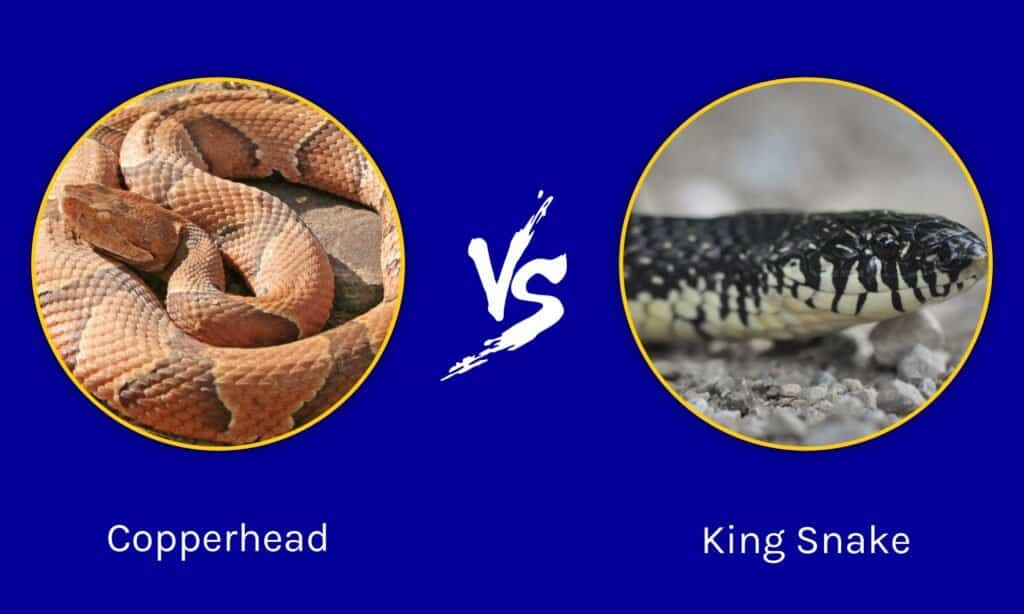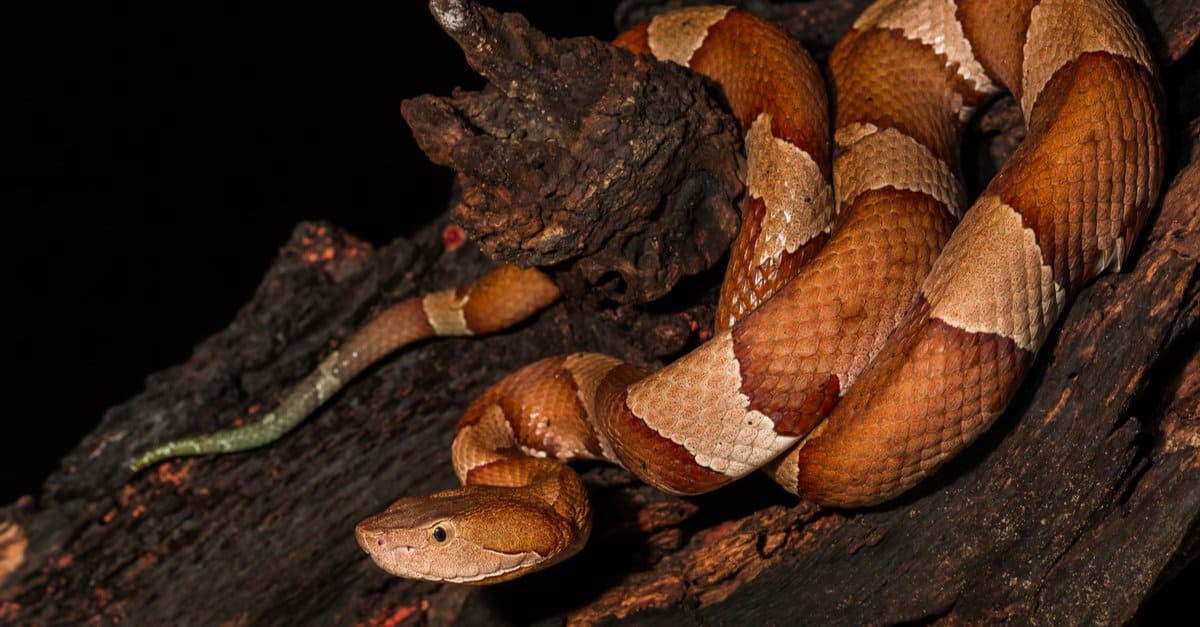Copperheads and kingsnakes are very similar in their mode of feeding. They are carnivorous. Also, in terms of appearance, Mole kingsnakes and copperheads have reddish-brown scales. However, there are a lot of differences that make both snakes very distinct. Regarding venom, one possesses venom and the other does not. I bet you would want to know which snake you can carry around.
Let’s see below how these snakes are set apart and their interesting characteristics.
Key Differences between Copperheads and Kingsnakes

The main differences between copperheads and kingsnakes are that they belong to different families, inhabit slightly different ranges, and have unique physical characteristics. They differ in size, reproduce by different methods, kill unique prey by different means, and only one of them poses a threat to humans.
Copperhead Vs Kingsnake: Comparison
| Copperhead | Kingsnake | |
| Scientific Classification | Family: Viperidae; Species Name: Agkistrodon contortrix | Family: Colubridae; Species name: Lampropeltis getula (common kingsnake) |
| Range | Central and eastern United States | Throughout North America, depending on species |
| Appearance | Copper and brown hues, hourglass, dumbbell or saddlebag markings, keeled scales | Tricolor or solid, Striped, banded, or saddled markings, smooth scales |
| Size | 2.5-foot length, on average | 4.3-foot length, on average |
| Reproduction | Ovoviviparous, birth to live young | Oviparous, lay eggs |
| Diet | Carnivorous | Carnivorous, Ohiophagous |
| Threat to humans | Most common venomous snake, mild venom | Nonvenomous, common as pets |
Copperhead Vs Kingsnake: Scientific Classification

Wildly variable, kingsnakes come in a vast array of colors and markings depending on subspecies.
©Murilo Mazzo/Shutterstock.com
The copperhead snake, also known as the eastern copperhead, is a pit viper of the family Viperidae. Its species name is Agkistrodon contortrix. The genus Agkistrodon is shared with cottonmouths and American moccasins. The word comes from the Greek ancistro, which means “hooked,” and odon, meaning “tooth.” Contortrix comes from the Latin contortus, meaning “twisted, complex or intricate,” in reference to the hourglass patches on these snake’s backs. So, the species name can be interpreted as a “hooked-tooth snake with twisted bands down its back.” The subspecies include the Southern Copperhead (Agkistrodon contortrix contortrix), Northern Copperhead (Agkistrodon contortrix mokasen), Osage Copperhead (Agkistrodon contortrix phaeogaster), and the Trans-pecos Copperhead (Agkistrodon contortrix pictigaster).
The kingsnake has nine recognized subspecies and is part of the largest snake family, Colubridae. The “king” part of their name refers to their tendency to eat other snakes, similar to the king cobra. Lampropeltis getula is the species name for the common kingsnake, also known as the eastern kingsnake or chain kingsnake. The genus name Lampropeltis is shared with milk snakes. It is derived from the Greek lampros, meaning “bright, brilliant, radiant,” and pelta, meaning “small shield.” This is in reference to their smooth scales. Some of the subspecies include the Gray-banded Kingsnake (Lampropeltis alterna), Prairie Kingsnake (Lampropeltis calligaster), and the Black Kingsnake (Lampropeltis nigra).
Copperhead Vs King Snake: Habitat & Range
Copperhead snakes and Kingsnakes are native to North America and inhabit different ranges depending on the subspecies. You can find copperheads throughout the central and eastern United States. They range from southern New England to eastern Kansas and Nebraska, then south to Texas and Florida. They also live in localized areas of Mexico. The kingsnakes occupy diverse areas throughout North America, depending on the subspecies. Copperheads and Kingsnakes live in forests and woodlands with rocky outcrops and hilly terrain. They live in areas with downed woody vegetation and low, wet woodlands, the edges of swamps, and riparian zones. Both snakes are sometimes associated with man-made areas: construction sites, sawdust piles, and suburban areas. They overwinter in crevices, abandoned burrows, caves, hollow logs, and building foundations.
Copperhead Vs Kingsnake: Appearance
Copperheads are known for their reddish-brown bodies with cross-band patterns of tan, copper, and rich brown. They’re the only type of snake that can display hourglass-shaped markings. Alternatively, these can look like a dumbbell or a saddle bag. Their heads are distinctive rich copper-brown, giving them their common name. Copperheads are heavy-bodied snakes and on average measure 2.5 ft long. Copperheads have keeled scales, meaning they’re rough in texture with a ridge down the center.
Kingsnakes vary greatly in appearance depending on subspecies. They grow to be 2 to 5 feet, on average. Overall, kingsnakes have an average of 4.3-foot body length. Eastern kingsnakes are large and glossy black snakes with yellow or sometimes white crossbars that extend the size of their bodies. Their heads are solid black with yellow or white spots. Some kingsnakes are tri-colors; others are one solid color. Some are banded while others are striped or saddled where the bands don’t fully encircle the body, making a blotchy saddle shape.
Copperhead Vs Kingsnake: Reproduction

Copperheads give birth to live young.
©Matt Jeppson/Shutterstock.com
Copperhead snakes are ovoviviparous. This means that they give birth to live young that have developed in the body of the mother snake. Upon delivery, baby snakes may stay with their mother for several days or until their first skin shedding. Male copperheads do not show any parental involvement. In contrast, kingsnakes are oviparous and lay eggs that hatch outside the body. After copulation, the male leaves and does not return. The female kingsnake lays her eggs and leaves the nest with no parental involvement.
Copperhead Vs Kingsnake: Diet
Although both copperheads and kingsnakes are carnivorous, they rely on different types of prey to meet their dietary needs. As pit vipers, copperheads have pit organs between their eye and nostril on either side that act like infrared cameras to detect the heat of warm-bodied prey nearby. They also use vision and chemoreceptors on their tongues to find food. Their diet consists mainly of small mammals like rodents, but they also eat other small reptiles, birds, insects, and carrion.
Kingsnakes are nonvenomous snakes that kill their prey by constriction. Their diet varies significantly across subspecies and includes mammals, amphibians, birds, other reptiles, eggs, and insects. Many are ophiophagous, meaning that they eat other snakes. Eastern and Florida kingsnakes consume primarily other snakes, including venomous ones like copperheads, coral snakes, and rattlesnakes. Kingsnakes may actually be immune to the venom of copperheads.
Copperhead Vs Kingsnake: Danger to Humans?

Kingsnakes are nonvenomous and common as pets.
©iStock.com/RobinOlimb
Copperhead snakes are responsible for the largest number of venomous snake bites per year in the United States. This is due to their ability to evade detection through cryptic coloration, remain motionless, and their association with human-occupied habitats. However, their venom is one of the least toxic North American snake species. Copperhead bites cause pain, edema, hemorrhage, fever, and lethargy but very rarely lead to death in humans. An article in JAMA estimates that copperheads bite about 2,920 people every year in the U.S., but the fatality rate is only 0.01%.
Kingsnakes will give an occasional defensive bite, but they are not venomous snakes. Along with boa constrictors, they’re one of the most common snakes to keep as pets. These snakes play an essential role in regulating the populations of venomous snakes, which can pose a threat to humans.
Discover the "Monster" Snake 5X Bigger than an Anaconda
Every day A-Z Animals sends out some of the most incredible facts in the world from our free newsletter. Want to discover the 10 most beautiful snakes in the world, a "snake island" where you're never more than 3 feet from danger, or a "monster" snake 5X larger than an anaconda? Then sign up right now and you'll start receiving our daily newsletter absolutely free.
Thank you for reading! Have some feedback for us? Contact the AZ Animals editorial team.








